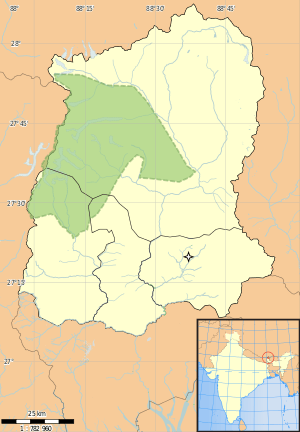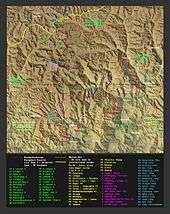Khangchendzonga National Park
| Khangchendzonga National Park | |
|---|---|
|
IUCN category II (national park) | |
 | |
| Location | North Sikkim, Sikkim |
| Nearest city | Chungthang |
| Coordinates | 27°42′0″N 88°08′0″E / 27.70000°N 88.13333°ECoordinates: 27°42′0″N 88°08′0″E / 27.70000°N 88.13333°E |
| Area | 1,784 km2 (689 sq mi) |
| Established | 1977 |
| Visitors | NA (in NA) |
| Governing body | Ministry of Environment and Forests, Government of India |
| Type | Mixed |
| Criteria | iii, vi, vii, x |
| Designated | 2016 (40th session) |
| Reference no. | 1513 |
| State Party | India |
Khangchendzonga National Park (previously named Kanchenjunga National Park) also Kanchenjunga Biosphere Reserve is a National Park and a Biosphere reserve located in Sikkim, India. It was inscribed to the UNESCO World Heritage Sites list on July 17, 2016, becoming the first "Mixed Heritage" site of India.[1] The park gets its name from the mountain Kanchenjunga (alternative spelling Khangchendzonga) which is 8,586 metres (28,169 ft) tall, the third-highest peak in the world. The total area of this park is 849.5 km2 (328.0 sq mi).
There are many glaciers in the park including the Zemu glacier. Animals like musk deer, snow leopard, Clouded Leopard[2], and Himalayan tahr all make their home in this park.
Human history
There are a few Lepcha tribal settlements inside the park.
Geography

The Kanchenjunga Park is situated in the North and West Sikkim districts in the Indian state of Sikkim. It has an elevation of 1,829 metres (6,001 ft) to over 8,550 metres (28,050 ft) and has an area of 849.50 km2 (327.99 sq mi). It is one of the few high altitude National parks of India. Recently, it is included in UNESCO's World Heritage sites.
In the north it adjoins the Qomolangma National Nature Preserve in Tibet, and in the east the Kanchenjunga Conservation Area in Nepal.[3]
Flora
The vegetation of the park include temperate broadleaf and mixed forests consisting of oaks, fir, birch, maple, willow etc. The vegetation of the park also includes alpine grasses and shrubs at higher altitudes along with many medicinal plants and herbs.
Fauna
The park contains many mammal species including musk deer, snow leopard, Himalayan tahr, wild dog, sloth bear, civet, Himalayan black bear, red panda, Tibetan wild ass, Himalayan blue sheep, serow, goral and takin, as well as reptiles including rat snake and Russell's viper.
A recent study revealed, that the Asiatic wild dog has become very rare in the area. The wild dogs in the Khangchendzonga Biosphere Reserve are believed to belong to the rare and genetically distinct subspecies C. a. primaevus.[4]
Avifauna
About 550 species of birds are found inside the park including blood pheasant, satyr tragopan, osprey, Himalayan griffon, lammergeier, Tragopan pheasant, green pigeon, Tibetan snowcock, snow pigeon, impeyan pheasant, Asian emerald cuckoo, sunbird and eagle. A new species of bird named Himalayan Forest Thrush has been found in 2016. It's scientific name is Zoothera Salimalii.
Park specific activities
Trekking
Most of the trekking routes starts from Yuksom (145 km (90 mi) from Gangtok) in West Sikkim. Necessary Permit can be obtained from the Wildlife Education and Interpretation center at Yuksom or from the check post. State Tourism Department along with other travel agents organize treks to Dzongri (4,050 metres (13,290 ft)) and other places. The popular trek routes are:
- Yuksom - Tshoka - Dzongri
- Bakim - Dzongri - Thangshing - Samuteng - Goechala
- Dzongri Base Camp - Rathong – Khangerteng
- Thangshing - Lam Pokhari - Kasturi Orar - Labdang not ladang - Tashiding.
Another popular trekking point includes trekking to the Green Lake with Lachen, a village in North Sikkim as the starting point. Foreign nationals would require a restricted area permit from the Ministry of Home Affairs, Government of India, Delhi to visit the park and the associated region. Indian nationals are required to obtain an Inner-Line Permit from the State Home Department. Permission of the State Chief Wildlife Warden is also mandatory for everybody visiting the park. The important and popular routes are:
- Lucanes Jakchen-Yabuk-Rest Camp (Marco Polo Camp) - Green Lake
- Lachen-Thasngu (13,695 feet (4,174 m)) - Muguthang (16,000 feet (4,900 m)) - Thay La (17,000 feet (5,200 m)) - Khyoksa La (18,000 feet (5,500 m)) - Rest Camp - Green Lake.
Most of these trekking routes pass through the Kanchenjunga National Park.
Lodging
Lodging can be done at the Range office where there are four rest houses with about 20 beds.
Approach
- Nearest airport:
- Bagdogra Airport, Darjeeling district, West Bengal (222 km (138 mi))
- Gangtok Helipad, East Sikkim district, Sikkim
- Nearest railhead: New Jalpaiguri, Siliguri Junction (221 km (137 mi))
- Nearest highway: NH 31A (Sevok – Gangtok)
- Nearest town: Yuksom in West and Chungthan in North (20 km (12 mi))
- Nearest city: Gangtok
General Information
The best season to visit the Kanchenjunga national park is between April to May. Snowfall is heavy during the winter months and monsoon showers occur from May to mid October.
Foreign nationals would require a restricted area permit from the Ministry of Home Affairs, Government of India, Delhi to visit the park and the associated region. Indian nationals are required to obtain an Inner-Line Permit from the State Home Department. Permission of the State Chief Wildlife Warden is also mandatory for everybody visiting the park.
References
- ↑ Tile: UNESCO approves all 3 Indian nominations for heritage tag, Publlisher: India Today news, Pblished on: 18 uly 2016, Accessed on: 18 July 2016
- ↑ Clouded leopard#Distribution and habitat
- ↑ Bhuju, U. R., Shakya, P. R., Basnet, T. B., Shrestha, S. (2007). Nepal Biodiversity Resource Book. Protected Areas, Ramsar Sites, and World Heritage Sites. International Centre for Integrated Mountain Development, Ministry of Environment, Science and Technology, in cooperation with United Nations Environment Programme, Regional Office for Asia and the Pacific. Kathmandu, Nepal. ISBN 978-92-9115-033-5
- ↑ Bashir, T. A. W. Q. I. R., et al. Precarious status of the Endangered dhole Cuon alpinus in the high elevation Eastern Himalayan habitats of Khangchendzonga Biosphere Reserve, Sikkim, India. Oryx (2013): 1-8.
External links
- Khangchendzonga National Park, WebIndia123
- Goecha La: In search of Kangchenjunga by George Thengummoottil - documentary on Goechala Trek inside Kangchenjunga National Park